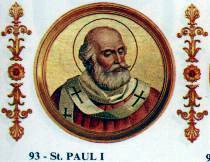Pope Paul I
|
|
This article has multiple issues. Please help improve it or discuss these issues on the talk page. (Learn how and when to remove these template messages)
(Learn how and when to remove this template message)
|
| Pope Saint Paul I |
|
|---|---|
 |
|
| Papacy began | 29 May 757 |
| Papacy ended | 28 June 767 |
| Predecessor | Stephen II |
| Successor | Stephen III |
| Personal details | |
| Born | Rome, Exarchate of Ravenna, Roman Empire |
| Died | 28 June 767 Rome |
| Other popes named Paul | |
| Papal styles of Pope Paul I |
|
|---|---|
 |
|
| Reference style | His Holiness |
| Spoken style | Your Holiness |
| Religious style | Holy Father |
| Posthumous style | Saint |
Pope Paul I (Latin: Paulus I; 700 – 28 June 767) was Pope from 29 May 757 to his death in 767. He first served as a Roman deacon and was frequently employed by his brother, Pope Stephen II, in negotiations with the Lombard kings.
Contents
Life[edit]
Paul and his brother Stephen had been educated for the priesthood at the Lateran palace. After Stephen's death on 26 April 757, Paul prevailed over a faction that wanted to make the Archdeacon Theophylact pope and was chosen his brother's successor by the majority that wished a continuation of the late pope's policy. The new pope's reign was dominated by relations with the Frankish and Lombard kings and with the Eastern emperor. He adopted an independent tone in informing the imperial Exarch in Ravenna of his election, but wrote to Pepin the Younger that the Frankish alliance should be maintained unimpaired. Paul was likely concerned of the danger posed by the Lombard king Desiderius.[1]
The Lombards held the cities of Imola, Osimo, Bologna, and Ancona, which were claimed by Rome, and in 758 seized upon the duchies of Spoleto and Benevento. On his return from suppressing a revolt in Benevento, Desiderius visited Rome and compelled Paul to write to Pepin asking him to concede all the Lombard claims. He promised to return Imola, but on condition that the pope should persuade Pepin to send back Lombard hostages held by the Franks.[1]
In a letter that was to secure the envoys a safe passage through Lombard territory, Paul agreed to the demands of Desiderius and begged Pepin to accede to the wishes of the Lombards by making a treaty of peace and returning the hostages. In a second secret letter, the Paul advised Pepin of the agreement of Desiderius with the Byzantines for the conquest of Ravenna, and implored Pepin to come to the aid of the pope, and to force the Lombard king to yield the towns retained by him.[1]
Pepin found it advisable to maintain good relations with Desiderius, and Paul apparently accomplished little by his double-dealing. Later, however, Pepin gave the pope some support and acted as arbiter between the Roman and Lombard claims.
In 765, papal privileges were restored in Beneventine and Tuscan territory and partially in Spoleto. Meanwhile, the alienation from Constantinople grew greater. Several times, especially in 759, Paul feared that the Eastern Roman Emperor would send an armament against the city of Rome. Paul lived in continual dread lest Eastern Roman ambitions turn the Frankish influence in favor of the Lombards. This was actually attempted, but Pepin held to his original foreign policy regarding Italy.
Paul died in Rome on 28 June 767.[1]
See also[edit]
References[edit]
External links[edit]
 Kirsch, J. P. (1913). "Pope Paul I". Catholic Encyclopedia.
Kirsch, J. P. (1913). "Pope Paul I". Catholic Encyclopedia. "Paul. The name of five popes. Paul I". New International Encyclopedia. 1905.
"Paul. The name of five popes. Paul I". New International Encyclopedia. 1905.
| Catholic Church titles | ||
|---|---|---|
| Preceded by Stephen II |
Pope 757–767 |
Succeeded by Stephen III |

